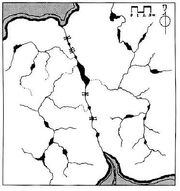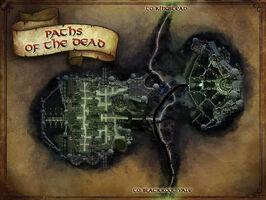
The Paths of the Dead overview

City of the Dead
- Type: Underground tomb complex
- Inhabitants: N/A
- Population: 0
- Origin: Used as a temple and burial ground by the Daen since the mid-Second Age; last interment in TA 679
- Purpose: Crypts for the royalty of the Daen Coentis; temple of Gobha or later Marec
The Paths of the Dead (S."fui ’ngorthrim") became the common designation in central Gondor for Lugh Gobha (Dn. "Gobha's Fortress"), the ancient mountain stronghold of the Daen Coentis, following the resettlement of the Mornan during the early centuries of the Third Age, after the greater part of the Daen Coentis had passed into the shadows. They were originally natural caverns beneath the White Mountains which connected the vale of Dunharrow to the Morthond valley. The mountain folk had enlarged these tunnels with the aid of Sauron, and used them as a burial site. The Lugh Gobha tunneled through the heart of the White Mountains, from the dark sources of the River Morthond on the south side to the grassy field of Slaem Puchael on the north. Over time, the subterranean grew into a sanctuary for the veneration of Gobha, a burial place for the Daen. and a fortress for the Morachd that ruled them.
Cursed by Isildur Elendilion, the spirits of the Oathbreakers haunted the Paths after they died, compelled to await the summons that would enable them to fulfill their oath. Because of the presence of the Dead, few living mortals dared to seek the Paths, though their original purpose had been to serve as a road linking the lands north and south of the mountains. Only the fading remnant of living Oathbreakers was able to enter the Paths without fear; yet even they were loath to tread those ways except for the purpose of bearing fallen comrades to their final resting place. All mortal races were subject to the terror of the Dead; only the deathless Elves were unaffected, though many traveling southwards in search of Edhellond prefered to take the mountain passes into central Gondor, rather than endure the eternally starless night of the Paths.None were believed to have passed through alive since the days of Elendil and Legend held that only the heir of Isildur could travel the Paths unmolested and demand service from the spirits which abode there.
After Aragorn Elessar summoned the Oathbreakers and released them from their curse in T.A. 3019, the Paths were cleansed of their horror and were no longer haunted (though few who had lived in the shadow of the fear inspired by the Dead would be willing to enter or even approach the Paths for many years to come).
As king Elessar decreed that the Paths should be left undisturbed and the treasures of the ancient Oathbreakers untouched; but he nevertheless permitted the tunnels to be used if speed of movement was needed, especially by his messengers and envoys. Moreover, Elessar entrusted the Prince of Belfalas and the King of Rohan to guard the entrances to die Paths from either side of the mountains, so that none could use that road except by the will of the King of Gondor.
The Paths of the Dead were dark, and natural light had little effectiveness in dispelling the shadows which seemed to cling to the walls as though they were a physical presence. Magical light, such as that created by an enchanted weapon or an incantation, was of a significantly greater use. When bearing the deceased into the Paths, the living Oathbreakers had been able to illuminate the long depleted torches which lined the walls in scones by a closely'-guarded ritual. The result was a ghostly luminescence that casted a grey light upon everything. The Oathbreakers did not teach this ritual to outsiders, though it was possible to learn.
Sections of the Paths[]
- Dark Door
- Dead Door
- Dimholt
- Kêr Bras
- Kêr Izel
- Lenn Dûskud - this was a vortex in the southeastern quarter of the great western dome where the Men of the Mountain communicated with Sauron.
- Shadow-watch
